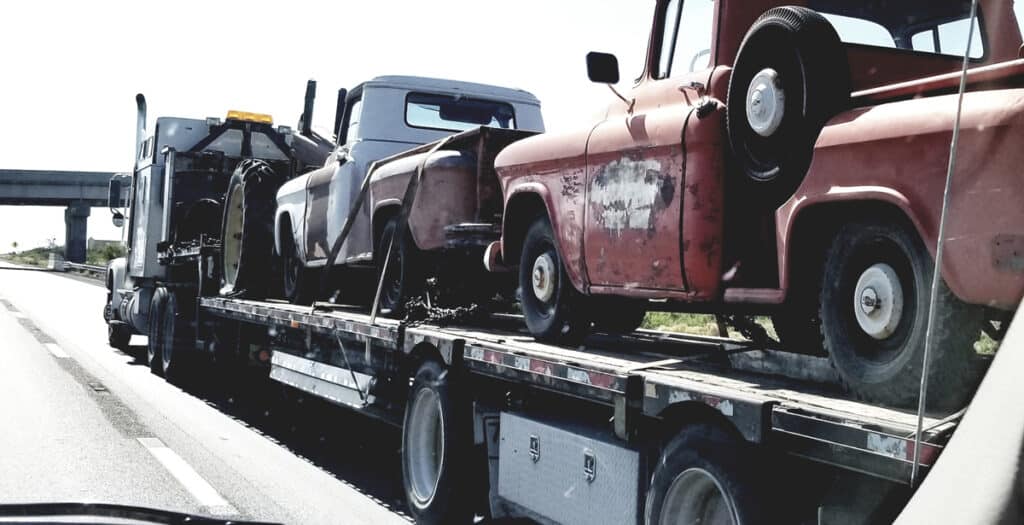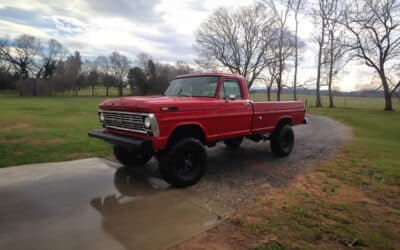In the realm of truck modifications, one of the most significant transformations you can undertake is converting a 2-wheel drive (2WD) vehicle to a 4-wheel drive (4WD) system.
This conversion not only elevates the off-road capabilities of your vehicle but also potentially enhances its resale value. Whether you’re a seasoned off-road veteran or a novice in the world of truck customization, understanding the intricacies of this conversion process is crucial.
We’re about to transform your trusty 2WD ride into a beastly 4WD off-road machine. This guide will break down everything you need to know, whether you’re a wrench-wielding DIYer or just want the lowdown before talking to the pros.
Forget boring, formal stuff. We’ll keep it clear, concise, and packed with info to get you ready to tackle any terrain that throws your way. Let’s go!

Jump to Section
Understanding the Basics of 2WD and 4WD
What Makes 2WD and 4WD Different in Trucks?
Before embarking on a conversion project, it’s important to understand the fundamental differences between 2WD and 4WD systems. A 2WD vehicle, as the name suggests, delivers power to either the front or rear wheels only. This setup is simpler and more fuel-efficient but offers less traction compared to 4WD, especially in off-road or adverse weather conditions.
In contrast, a 4WD system is designed to provide power to all four wheels simultaneously, offering enhanced traction and stability. This is particularly beneficial for off-road driving, navigating rough terrains, or during challenging weather conditions. The additional grip and power distribution in a 4WD system can make a significant difference in the vehicle’s capability.
Advantages of 4WD Systems
The primary advantage of a 4WD system is its superior traction, which is essential for off-road adventures. This traction ensures that the vehicle can navigate through mud, snow, sand, and other challenging terrains where a 2WD vehicle might struggle or get stuck. Additionally, 4WD systems offer improved towing capabilities and stability, which is a boon for those who frequently haul heavy loads or traverse hilly landscapes.
Key Components for 2WD to 4WD Conversion
Essential Parts for the Conversion Process
When planning a 2WD to 4WD conversion, understanding and sourcing the right components is crucial. The conversion requires several key parts, each playing a vital role in the functionality of the 4WD system. Here’s a breakdown of the essential components needed:
- Transfer Case: The heart of the 4WD system, responsible for distributing power to both the front and rear axles.
- Front Driveshaft: Connects the transfer case to the front axle, enabling power transmission to the front wheels.
- Front Axle Assembly: Includes the differential, axle shafts, and related components necessary for the front wheels’ movement and traction.
- Transmission Tail-shaft or Output Shaft: This component must be compatible with the transfer case to ensure seamless power transmission.
- Control Arms and Suspension Parts: Essential for supporting the vehicle’s frame and maintaining wheel alignment.
- Transfer Case Gear Shifter: Allows the driver to engage and disengage the 4WD system.
- Wiring Harness and Electronics: For vehicles with electronic systems, ensuring compatibility with the 4WD components is essential.

Sourcing the Components
Finding the right parts for your conversion project is a crucial step. Here are some tips for sourcing these components:
- Donor Vehicles: Consider purchasing a donor vehicle, especially if it shares the same model line as your truck. This ensures compatibility and often provides a cost-effective solution for obtaining all necessary parts.
- Aftermarket Kits: Many companies offer comprehensive 4WD conversion kits tailored to specific models. These kits usually contain all the necessary components, simplifying the sourcing process.
- Specialty Suppliers: For older or less common models, specialty automotive suppliers can be invaluable for finding rare or custom parts.
Compatibility and Integration (Make Converting Easier)
Ensuring compatibility between the new 4WD components and your vehicle’s existing systems is vital. Pay special attention to:
- Model-Specific Requirements: Different models may have unique requirements or limitations for 4WD conversion. Researching your specific model is crucial.
- Electrical and Electronic Systems: For newer models with advanced electronic systems, ensuring that the new 4WD components integrate seamlessly is critical to maintain functionality and safety.
- Mechanical Fitment: Physical compatibility, such as mounting points and drivetrain alignment, is essential for a successful conversion.
Conversion Process Overview
Step-by-Step Guide for 2WD to 4WD Conversion
Converting a 2WD truck or SUV to a 4WD system is a detailed process that requires mechanical skill and precision. Here’s a simplified overview of the steps involved:
- Transmission Modification or Swap: Begin by modifying the existing 2WD transmission to accommodate the 4WD system, or swap it with a 4WD transmission. This involves replacing the output shaft and possibly the extension housing.
- Install Transfer Case: The transfer case, being the core of a 4WD system, needs to be installed. It’s critical to choose a transfer case compatible with your vehicle’s model and transmission.
- Front Axle and Drive Shafts: Install the front axle assembly, including the differential, axle shafts, and hub assembly. Next, install both front and rear drive shafts to connect the transfer case to the axles.
- Suspension and Steering Adjustments: Upgrade the suspension to handle the added weight and altered dynamics. This may include new control arms, springs, and shock absorbers. Ensure the steering system is compatible with the new front axle setup.
- Wiring and Electronics Integration: For vehicles with electronic control systems, integrate the 4WD system into the existing vehicle electronics. This includes modifying the wiring harness and ensuring that all electronic components are functioning correctly.
- Final Assembly and Testing: Once all parts are installed, perform a thorough check of all connections, bolts, and mechanical components. Test the vehicle in a controlled environment to ensure the 4WD system operates as expected.

Model-Specific Considerations
- Chevy/GM Squarebody Trucks: These models might require specific parts like front SAS (Solid Axle Swap) kits and certain transfer cases designed for these vehicles.
- Ford F-Series Trucks: For older model Fords, the conversion can be simpler due to the shared chassis between 4×2 and 4×4 models. Ensure you source the correct suspension and axle components.
- Ford Ranger: Depending on the year and model, the conversion process can vary. Pay close attention to the suspension type (IFS or SFA) and ensure compatibility with the selected transfer case and drivetrain components.
Choosing the Right Conversion Kit
Types of Conversion Kits
Conversion kits can greatly simplify the 2WD to 4WD conversion process. They come in various types, each tailored to different needs and skill levels:
- Basic Kits: These kits usually include essential components like front axle assemblies, transfer cases, and basic suspension parts. Ideal for those who have some of the other necessary components already or who want to customize their build further.
- Advanced Kits: These include more comprehensive components, such as upgraded suspension systems, custom axles, and specialized steering setups. Suitable for those looking for a more robust conversion with higher performance.
- Complete Kits: The most comprehensive option, these kits provide everything needed for the conversion. They are perfect for those who want a one-stop solution without the need to source individual parts.
Factors to Consider When Choosing a Kit (Convert Faster!)
- Compatibility with Your Vehicle: Ensure the kit is designed for your specific make and model.
- Intended Use of the Vehicle: Consider whether the vehicle will be used primarily for off-roading, daily driving, or a mix of both. This will influence the type of kit you should choose.
- Skill Level and Tools Required: Assess your mechanical skill level and the tools you have available. Some kits may require more advanced mechanical knowledge and specialized tools.
- Budget: Kits can vary significantly in price. Set a budget and find a kit that offers the best balance between cost and the components you need.
DIY vs. Professional Conversion
Weighing the Options for 2WD to 4WD Conversion Kits for Your Old Truck or SUV
The decision to undertake a 2WD to 4WD conversion as a DIY project or to enlist professional help is significant. Both options have their advantages and challenges:
DIY Conversion
- Pros:
- Cost-Effectiveness: Generally more budget-friendly as labor costs are saved.
- Learning Experience: Offers an opportunity to gain in-depth knowledge about your vehicle’s mechanics.
- Personal Satisfaction: Completing such a project can be highly rewarding.
- Cons:
- Time-Consuming: Requires a significant time investment.
- Skill Level: Demands a good understanding of automotive mechanics and access to the right tools.
- Risk of Mistakes: Without professional experience, the risk of errors, which can be costly, increases.
Professional Conversion
- Pros:
- Expertise: Professionals have the experience and knowledge to handle complex conversions.
- Time Efficiency: A professional job is typically completed faster than DIY.
- Quality Assurance: Professional work often comes with warranties or guarantees.
- Cons:
- Higher Cost: Professional services can significantly add to the overall cost of the conversion.
- Less Personal Involvement: You may miss out on the hands-on experience and learning opportunities.
Making the Decision
Consider the following factors when deciding between DIY and professional conversion:
- Your Mechanical Skill Level: Honestly assess your abilities and experience in automotive mechanics.
- Availability of Tools and Space: Ensure you have access to the necessary tools and a suitable workspace.
- Budget Constraints: Professional conversions can be expensive; balance this against the potential challenges and risks of DIY.
- Time Availability: DIY projects can take considerable time. Ensure you have enough availability to complete the project without undue stress.

Post-Conversion Considerations
Adjustments and Adaptations Post 2WD to 4WD Conversion Swap
After converting a 2WD vehicle to 4WD, several adjustments and considerations are necessary to ensure the vehicle operates optimally:
Fuel Consumption and Engine Performance
- Increased Fuel Usage: The additional weight and mechanical components of a 4WD system can lead to increased fuel consumption.
- Potential for Reduced Performance: The extra weight and drag of the 4WD components might impact engine performance.
- Engine Upgrades: Consider upgrading the engine to offset any performance loss, including installing exhaust systems, filters, or even modifying the pistons.
Suspension Upgrades
- Handling Increased Weight: The added weight of the 4WD components necessitates upgrading the suspension system.
- Upgraded Dampers and Leaf Packs: These are essential to accommodate the added weight and maintain vehicle stability and handling.
Drivetrain Stress in Full-Time 4WD Systems
- Continuous Load on Drivetrain: Full-time 4WD systems put constant stress on the drivetrain, potentially leading to increased wear and tear.
- Regular Maintenance: Regular checks and maintenance become even more important to prevent premature failures.
Conclusion: Embracing the 2WD to 4WD Conversion Journey
Embarking on a 2WD to 4WD conversion journey for an old truck or SUV is both challenging and rewarding. This comprehensive guide aimed to equip you with the knowledge and insights necessary to navigate this process, whether as a DIY project or with professional assistance.
Key Takeaways on How to Convert Your Truck or SUV
- Informed Decision-Making: Understanding the complexities of 2WD to 4WD conversions is crucial for making informed decisions, ensuring the right approach for your specific vehicle and needs.
- Component Knowledge: Familiarity with the essential components and their roles in the conversion process helps in planning and executing the project effectively.
- Balancing DIY and Professional Help: Weighing the pros and cons of DIY versus professional conversion is essential. Consider your mechanical skills, budget, and time constraints.
- Post-Conversion Adjustments: Be prepared for changes in fuel consumption, engine performance, and the need for suspension upgrades. Regular maintenance is key to the longevity of your newly converted 4WD vehicle.
Additional resources:
- Consult a professional mechanic for specific advice and part selection.
- Refer to mechanic association resources for technical advice and legal aspects.
Final Thoughts
The conversion from 2WD to 4WD opens up a new world of possibilities for your vehicle, enhancing its capabilities and potentially its value. Whether it’s for improved off-road performance, personal satisfaction, or a passion for automotive projects, this transformation is a significant undertaking that can yield great rewards.
Remember, each vehicle and conversion project is unique. Take the time to research, plan, and gather all the necessary resources and knowledge before diving into this venture. And most importantly, enjoy the journey of transforming your truck or SUV into a more capable and robust 4WD vehicle.



